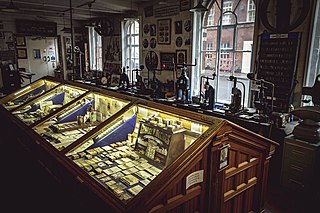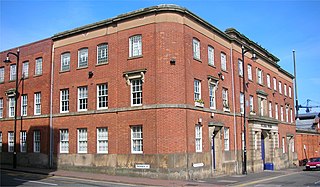
A fountain pen is a writing instrument that uses a metal nib to apply water-based ink, or special pigment ink—suitable for fountain pens—to paper. It is distinguished from earlier dip pens by using an internal reservoir to hold ink, eliminating the need to repeatedly dip the pen in an inkwell during use. The pen draws ink from the reservoir through a feed to the nib and deposits the ink on paper via a combination of gravity and capillary action. Filling the reservoir with ink may be achieved manually, via the use of an eyedropper or syringe, or via an internal filling mechanism that creates suction or a vacuum to transfer ink directly through the nib into the reservoir. Some pens employ removable reservoirs in the form of pre-filled ink cartridges.

A pen is a common writing instrument that applies ink to a surface, usually paper, for writing or drawing. Early pens such as reed pens, quill pens, dip pens and ruling pens held a small amount of ink on a nib or in a small void or cavity that had to be periodically recharged by dipping the tip of the pen into an inkwell. Today, such pens find only a small number of specialized uses, such as in illustration and calligraphy. Reed pens, quill pens and dip pens, which were used for writing, have been replaced by ballpoint pens, rollerball pens, fountain pens and felt or ceramic tip pens. Ruling pens, which were used for technical drawing and cartography, have been replaced by technical pens such as the Rapidograph. All of these modern pens contain internal ink reservoirs, such that they do not need to be dipped in ink while writing.

A dip pen is a writing instrument used to apply ink to paper. It usually consists of a metal nib with a central slit that acts as a capillary channel like those of fountain pen nibs, mounted in a handle or holder, often made of wood. Other materials can be used for the holder, including bone, metal and plastic; some pens are made entirely of glass.

Joseph Gillott was an English pen-manufacturer and patron of the arts based in Birmingham.

George Richards Elkington was a manufacturer from Birmingham, England. He patented the first commercial electroplating process.

The Jewellery Quarter is an area of central Birmingham, England, in the north-western area of Birmingham City Centre, with a population of 19,000 in a 1.07-square-kilometre (264-acre) area.

Rotring is a manufacturer of technical drawing tools and writing implements. Established in Germany in 1928 as a fountain pen manufacturer, Rotring went on to be acquired by Newell Brands in 1998. The name "Rotring" directly translates to "red ring", which refers to the company's signature: a red band placed around the barrel of the pen. The company's name was changed to Rotring in the early 1970s to match the trademark.

Pilot Corporation is a Japanese pen manufacturer based in Tokyo. It produces writing instruments, stationery and jewellery, but is best known for its pens.

A nib is the part of a quill, dip pen, fountain pen, ball point, or stylus which comes into contact with the writing surface in order to deposit ink. Different types of nibs vary in their purpose, shape and size, as well as the material from which they are made.

A Flex nib is a type of fountain pen nib that can create different line widths. Due to its non-rigid structure, a flex nib allows a writer to control line width by adjusting the pressure of the pen on paper. Increased pressure will cause the two tines of the nib to separate slightly, allowing more ink to flow onto the page. A lighter grip will allow the tines to remain close together and produce a thinner line. The range of line widths from a fountain pen is limited; however, the most flexible nibs can produce a width about six times greater than that of a regular nib. One of the most flexible nibs are sometimes known among collectors as "wet noodles".

The Pen Museum is a museum in Birmingham, England, covering the history of Birmingham's steel pen trade. The only museum in the United Kingdom devoted to the history of the pen making industry, the Pen Museum explains how Birmingham became the centre of the world pen trade.

The Victoria Works is a Grade II listed building in the Jewellery Quarter of Birmingham, England. It was built in 1839–40 for Joseph Gillott, who manufactured pen nibs, and was one of the first purpose-built factories in the Jewellery Quarter. It is situated opposite the Argent Centre, another building constructed for industrial use around the same period. The factory was one of the largest of its kind, with nearly 600 workers. Steam engines of 60 horsepower powered the mass production of the nibs.

Macniven and Cameron Ltd., later known as Waverley Cameron Ltd., was a printing and stationery company based in Edinburgh, Scotland. The company was best known for its pen nibs, the "Pickwick", the "Owl", and the "Waverley", which were sold under the advertising doggerel:
They come as a boon and a blessing to men,
the Pickwick, the Owl and the Waverley Pen.
The Esterbrook Pen Company is a former American manufacturing company founded by English immigrant Richard Esterbrook and based in Camden, New Jersey. It was the largest pen manufacturer in the United States, having reached a record of producing 216,000,000 pens a year. The company produced dip pens, then concentrating on fountain pens until it was acquired by Venus Pencils in 1967, ceasing activities in 1971.
Perry & Co., Ltd was a dip pens manufacturer of England. The company was the largest in its country of origin, producing a huge range of models. Perry & Co. also manufactured bicycle chains and accessories.
Speedball is a US manufacturing company of stationery and art products, based in Statesville, North Carolina. The company was originally established as the "C. Howard Hunt Pen Company" in 1899, to manufacture dip pens.
Leonardt Ltd. is an English manufacturing company that specializes in finishing of metal components, manufacturing products such as corners for stationery such as leathergoods, photograph albums, menu covers, pattern and carpet books, binders and portfolios.
Joseph Gillott's was an English manufacturing company based in Birmingham founded by Joseph Gillott in 1827 that produced high-quality dip pens. In 1961, Joseph Gillott's was taken over by British Pens Ltd., becoming a brand of it. Pen lines with the Gillott's name were manufactured in the British Pens factory of West Midlands, and currently commercialised by William Mitchell Ltd, one of the brands of the corporation.















